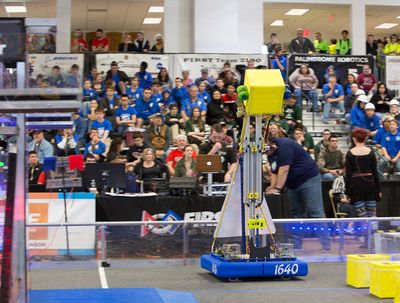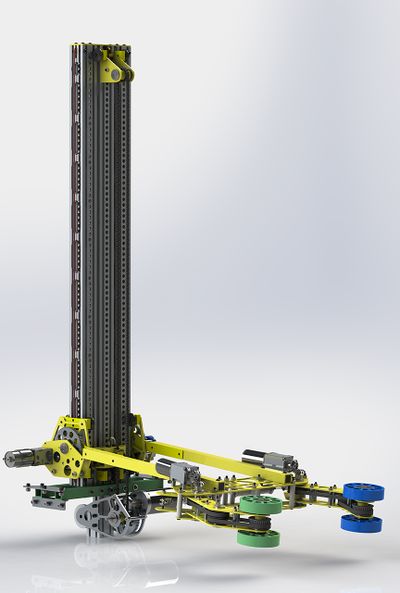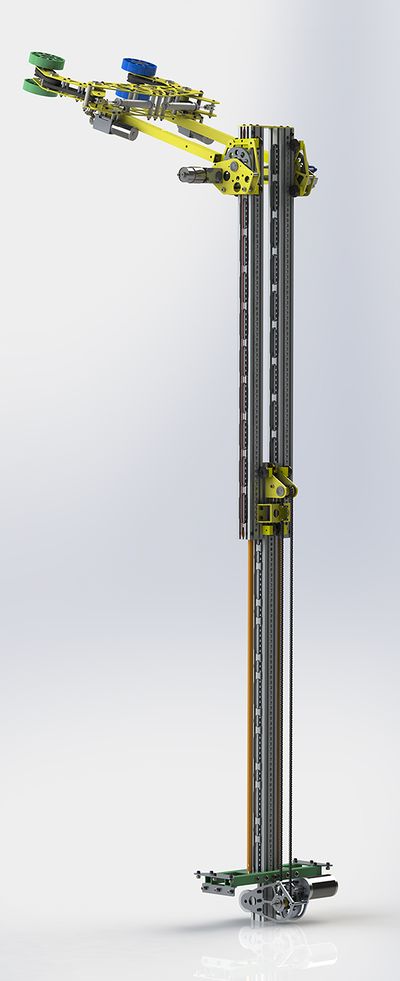Difference between revisions of "DEWBOT XIV Lift"
MaiKangWei (talk | contribs) (→Center Post Lift) |
MaiKangWei (talk | contribs) (→Center Post Lift) |
||
| Line 15: | Line 15: | ||
Key advantages of this inverted, or "inside-out" design are: | Key advantages of this inverted, or "inside-out" design are: | ||
| − | + | - The design enables arm & claw rotation over the lift top and toward the robot back for back scoring | |
| − | + | - By keeping the lift compact, left-to-right, racking and jamming is more easily avoided | |
| − | + | - The design allows high reach and careful and flexible placement of Power Cubes | |
| − | + | - The design manages Center-of-Gravity very effectively - [[DEWBOT XIV]] is visibly more stable than other effective lift-scale robots | |
The center post and stage 1 frame elements are 80/20 2020 (2" x 2") profiles. These profiles are extensively relieved to reduce weight and manage center-of-mass. High center-of-mass is an occupational hazard for scale-capable Power-Up robots. | The center post and stage 1 frame elements are 80/20 2020 (2" x 2") profiles. These profiles are extensively relieved to reduce weight and manage center-of-mass. High center-of-mass is an occupational hazard for scale-capable Power-Up robots. | ||
Revision as of 12:54, 14 April 2018
DEWBOT XIV's key scoring feature is a lift with an arm and roller claw. The key design objectives are:- Ability to score via scale, switch and exchange
- Ability to score in "lost" scale on 2nd level (defines scoring height)
- Ability to rotate arm to back to score in autonomous without having to turn around
- Lift time from pick-up to scale scoring ~ 1 sec
The lift is a 2-stage, single center post, cascade design. The main structural elements (stage 0 & 1) comprise 80/20 2020 profiles with 80/20 2752 roller wheel brackets. The 2nd stage comprises a carriage with arm drive, arms and roller claw.
The objective of scoring from either the front or rear of the robot (to facilitate autonomous scoring) drove the selection of a center post approach. The arm is able to rotate above the top of the lift when the lift is raised and allows the robot to score in the scale from the robot's rear. Earlier concepts employed a conventional frame lift with the thought that the claw could translate within this frame, but calculations revealed that passing the claw through a frame that fits on the short axis of the robot was impractical.Center Post Lift
Typical lifts employ two fixed posts (left and right - stage 0) with a moving frame (stage 1) between these. A carriage (stage 2) can ride within this frame to provide double lift.A center post design inverts this model. A single fixed post provides the foundation for the lift (stage 0). A compact frame (stage 1) is driven up and down on this center post. A carriage (stage 2) rides outside the compact frame. The result is a very compact lift, allowing arm & claw rotation outside and over the lift for scale scoring to the front and back of the robot.
Key advantages of this inverted, or "inside-out" design are: - The design enables arm & claw rotation over the lift top and toward the robot back for back scoring - By keeping the lift compact, left-to-right, racking and jamming is more easily avoided - The design allows high reach and careful and flexible placement of Power Cubes - The design manages Center-of-Gravity very effectively - DEWBOT XIV is visibly more stable than other effective lift-scale robots
The center post and stage 1 frame elements are 80/20 2020 (2" x 2") profiles. These profiles are extensively relieved to reduce weight and manage center-of-mass. High center-of-mass is an occupational hazard for scale-capable Power-Up robots.
80/20 2752 roller brackets with custom rollers allow the lift elements to move relative to each other. Custom rollers resolve a binding issue created by the stock rollers.


